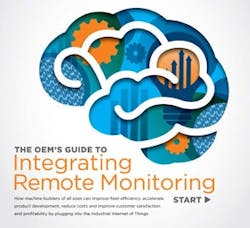The same massive demographic and technological shifts that are challenging manufacturers to do more with less are providing a unique opportunity for smart OEMs to provide higher levels of service, quality and expertise—all while creating new revenue channels— through the integration of remote monitoring.
Many small to midsized OEMs believe it is beyond their capability or expertise to offer advanced remote monitoring and predictive maintenance services on their machines. In fact, the confluence of plug-and play connected field monitoring equipment, secure internet-enabled cloud computing, simple data analysis tools, and subscription-based monitoring services has put this crucial capability within reach of all machine builders who have the desire to provide this valuable and profitable service.
Implementing a successful remote monitoring system requires three things:
- Secure data collection, storage and transmission that protects the OEM’s and customer’s data;
- Analytics software that allows OEMs to identify relevant data; and
- A channel to get the right information to the right person at the right time.
Some OEMs may be overwhelmed by the thought of developing such a system. But off-the-shelf systems developed by major manufacturing OEMs can put remote monitoring capabilities within reach for even the smallest machine builders.
Why remote monitoring? Why now?
Worldwide, manufacturers are under ever increasing pressure to compete in a market whose workforce and technology are being revolutionarily transformed. It is estimated that as much as 40% of the existing skilled manufacturing workforce will retire by 2020. Vast stores of knowledge essential to efficient plant operation will leave along with these educated workers. In response, manufacturers are seeking ways to limit the impact of this resource drain, and it is certain that many vacated positions will not be filled. Manufacturers are looking to technology—and their OEMs—to fill the void by providing tools for improved efficiency, productivity and profitability.
Add to this the explosion in the number of connected machines in factories and increased pressure on manufacturer CIOs to run more efficient operations through effective data analysis, and you have the makings of a radical transformation in the way manufacturing business is conducted. With connected machines, manufacturers expect to be able to do more with fewer resources; and that means they will be replacing only a small percentage of the positions that will be opened up through retirement.
In this new paradigm, manufacturers are already putting pressure on OEMs to provide solutions. Machine builders who can answer this challenge stand to benefit from long-term customer satisfaction and loyalty as well as streamlined product development, improved product insights and new revenue streams.
About the Author
Steve Diogo
digital media director

Leaders relevant to this article:
